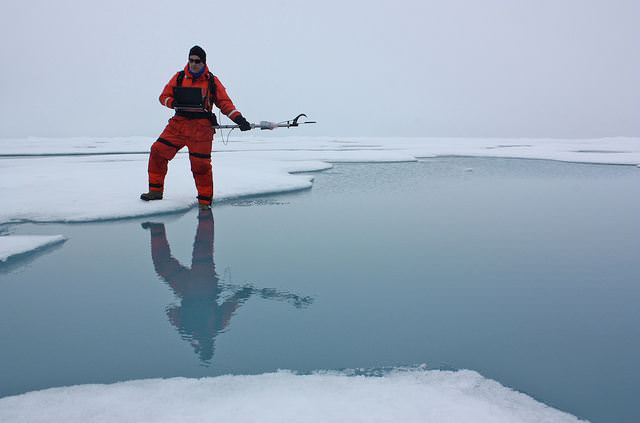

Don Perovich, part of the ICESCAPE mission used a spectroradiometer to measure the amount of sunlight reflected from the surface of ice and melt ponds in the Chukchi Sea. Credit: NASA/Kathryn Hansen
[/caption]
Imagine finding a rainforest in the middle of a desert. That is how NASA scientists are equating a new biological discovery in Arctic Ocean. Microscopic plants called phytoplankton are actively growing under the thinning Arctic ice. In fact, the scientists say the phytoplankton growth in the Arctic may now be richer than any other ocean region on Earth. The finding reveals a new consequence of the Arctic’s warming climate, and gives researchers an important clue to understanding the impacts of a changing climate and environment on the Arctic Ocean and its ecology.
“If someone had asked me before the expedition whether we would see under-ice blooms, I would have told them it was impossible,” said Kevin Arrigo of Stanford University, leader of the ICESCAPE mission and lead author of the new study. “This discovery was a complete surprise.”
ICESCAPE, stand for Impacts of Climate on EcoSystems and Chemistry of the Arctic Pacific Environment and in 2010 and 2011, scientists explored Arctic waters in the Beaufort and Chukchi seas along Alaska’s western and northern coasts onboard a U.S. Coast Guard icebreaker. The researchers drilled down through three-foot thick sea ice to study impacts of environmental variability and change in the Arctic on the ocean biology, ecology and biogeochemistry.
The researchers found the phytoplankton were extremely active, doubling in number more than once a day. Conversely, blooms in open waters grow at a much slower rate, doubling in two to three days. These growth rates are among the highest ever measured for polar waters.
Phytoplankton were thought to grow in the Arctic Ocean only after sea ice had retreated for the summer.
In July of 2011 the researchers observed blooms beneath the ice that extended from the sea-ice edge to 72 miles into the ice pack. Ocean current data revealed that these blooms developed under the ice and had not drifted there from open water, where phytoplankton concentrations can be high.
Previously, it was thought that sea ice blocked most sunlight needed for phytoplankton growth. Scientists now think that the thinning Arctic ice is allowing sunlight to reach the waters under the sea ice, spurring plant blooms where they had never been observed. The findings were published today in the journal Science.
Phytoplankton is the base of the marine food chain and they consume large amounts of carbon dioxide. Scientists will have to reassess the amount of carbon dioxide entering the Arctic Ocean through biological activity if the under-ice blooms turn out to be common.
“At this point we don’t know whether these rich phytoplankton blooms have been happening in the Arctic for a long time and we just haven’t observed them before,” Arrigo said. “These blooms could become more widespread in the future, however, if the Arctic sea ice cover continues to thin.”
The discovery of these previously unknown under-ice blooms also has implications for the broader Arctic ecosystem, including migratory species such as whales and birds. Phytoplankton are eaten by small ocean animals, which are eaten by larger fish and ocean animals. A change in the timeline of the blooms can cause disruptions for larger animals that feed either on phytoplankton or on the creatures that eat these microorganisms.
“It could make it harder and harder for migratory species to time their life cycles to be in the Arctic when the bloom is at its peak,” Arrigo said. “If their food supply is coming earlier, they might be missing the boat.”
The scientists said the discovery also may have major implications for the global carbon cycle and the ocean’s energy balance, and they may need to revise their understanding of the ecology of the Arctic and the region’s role in the Earth system.
You can see more images from the ICESCAPE expedition on NASA Goddard’s Flickr page.
The team’s paper: K.R. Arrigo et al. Massive phytoplankton blooms under Arctic sea ice. Science. doi:10.1126/science.1215065.
Source: NASA
The hunt for aliens goes hand in hand with the hunt for habitable planets. Astronomers…
Computers are an integral part of space exploration, keeping them functioning when away from Earth.…
By the end of this decade, NASA, the Chinese National Space Agency (CNSA), Roscosmos, and…
Could a new, fifth force of nature provide some answers to our biggest questions about…
In 2015, the United Nations adopted the 2030 Agenda for Sustainable Development—the Sustainable Development Goals…
Astronomers have been battling threats to their clear skies on all fronts lately. One of…